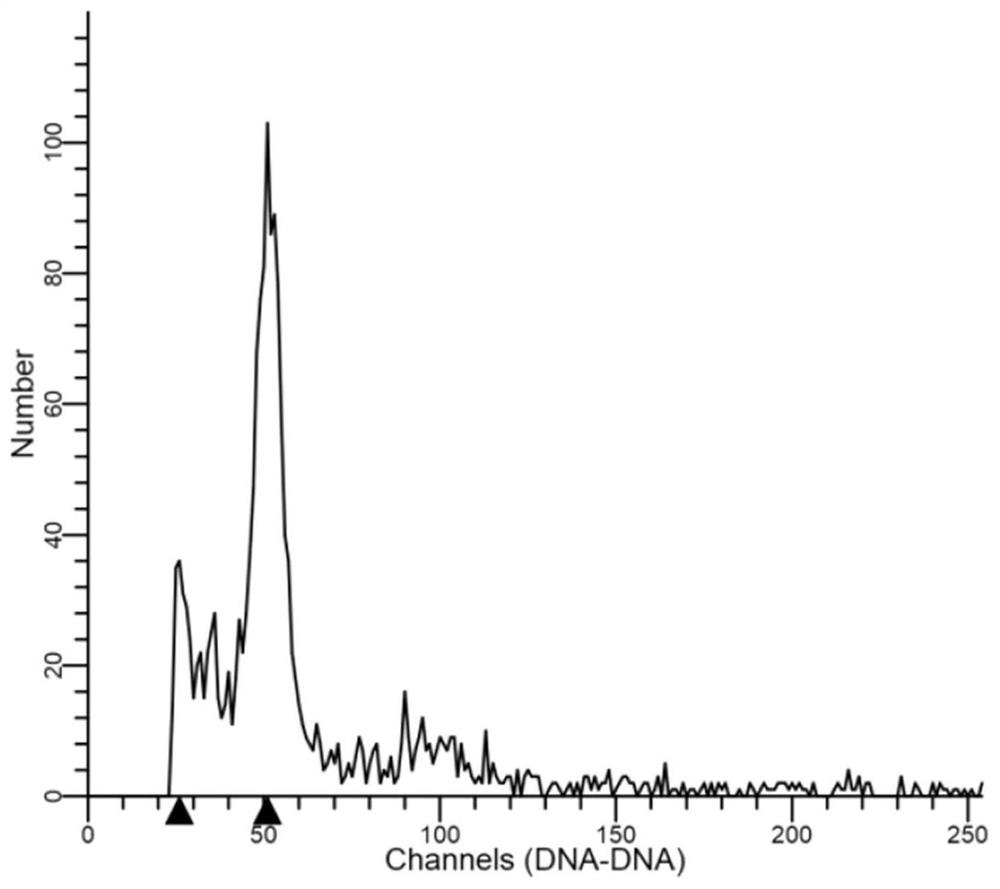A kind of method and application of cultivating polyploid poplar
A technology of polyploidy and poplar, applied in the fields of application, botany equipment and methods, cultivation, etc., can solve the problems of high technical level requirements for aseptic operation, complicated operation steps, and heavy experimental workload, etc., and achieve the goal of improving breeding Efficiency, shorter breeding cycle, and less work
- Summary
- Abstract
- Description
- Claims
- Application Information
AI Technical Summary
Problems solved by technology
Method used
Image
Examples
Embodiment 1
[0040] The poplar test material selection research group used in this embodiment collected the hard branch cuttings of the diploid poplar species 'Huilin 88' from Tongliao Academy of Forestry, Inner Mongolia, with a thickness of 2.2 cm and a length of 12 cm.
[0041] 1. Cuttings
[0042] In the greenhouse of Beijing Forestry University, the cuttings of 'Huilin 88' were placed in a flowerpot of 25cm (inner diameter) × 25cm (height), and the cutting substrate sterilized by high temperature and high pressure was filled in the flowerpot, and the substrate was peat soil: Perlite: river sand = 2:1:1, water the cuttings thoroughly, cover with plastic film and cultivate at 15-25°C and 50-80% relative humidity.
[0043] 2. Double processing
[0044] About 3 days after cutting, callus formation can be observed in the cambium area of the cutting surface ( figure 1 ), the callus developed further after cutting 8 days. At this point, completely cover the cut surface of the cuttings with...
Embodiment 2
[0052] The test material of this embodiment is the tetraploid hard branch cuttings of Populus papillodis that were induced by the research group in the early stage, with a thickness of 2.6 cm and a length of 12 cm.
[0053] 1. Cuttings
[0054] In the greenhouse of Beijing Forestry University, the cuttings of the tetraploid Populus pachyrhiza were cut in a flowerpot of 25cm (inside diameter) × 25cm (height), and the cutting substrate sterilized by high temperature and high pressure was filled in the flowerpot, and the substrate was peat soil : perlite: river sand = 2:1:1, water the cuttings thoroughly, and cover with plastic film to cultivate at 15-25°C and 50-80% relative humidity.
[0055] 2. Double processing
[0056] About 5 days after cutting, callus formation can be observed in the cambium area of the cutting surface, and the callus further develops after 10 days of cutting. At this point, completely cover the cut surface of the cuttings with absorbent cotton, add dr...
Embodiment 3
[0064] The poplar test material selection research group used in this embodiment collected the hard branch cuttings of the diploid poplar species 'Huilin 88' from Tongliao Academy of Forestry, Inner Mongolia, with a thickness of 2.2 cm and a length of 12 cm.
[0065] 1. Hydroponics
[0066] In the greenhouse of Beijing Forestry University, the hard branch cuttings of 'Huilin 88' were hydroponically cultured in a 10cm (upper inner diameter) × 20cm (height) plastic water cup filled with tap water and placed at 15-25°C and 50-80°C. % relative humidity and change the water every 2 days.
[0067] 2. Double processing
[0068] After hydroponics for about 6 days, callus formation can be observed in the cambium area of the cutting surface, and the callus develops further after hydroculture for 10 days. At this point, completely cover the cut surface of the cuttings with absorbent cotton, add dropwise 0.05% colchicine solution to avoid light for 24 hours, remove the absorbent cotto...
PUM
 Login to View More
Login to View More Abstract
Description
Claims
Application Information
 Login to View More
Login to View More - R&D
- Intellectual Property
- Life Sciences
- Materials
- Tech Scout
- Unparalleled Data Quality
- Higher Quality Content
- 60% Fewer Hallucinations
Browse by: Latest US Patents, China's latest patents, Technical Efficacy Thesaurus, Application Domain, Technology Topic, Popular Technical Reports.
© 2025 PatSnap. All rights reserved.Legal|Privacy policy|Modern Slavery Act Transparency Statement|Sitemap|About US| Contact US: help@patsnap.com



